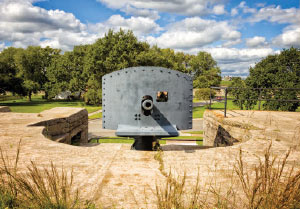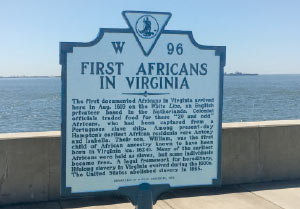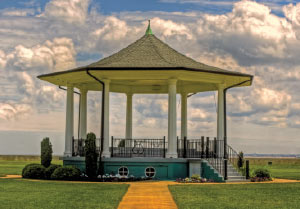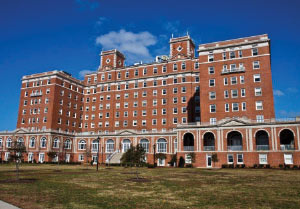★Fort Monroe Visitor and Education Center
Through the adaptive reuse of an original Beaux Arts style building, which was first built as a Library in 1909 by the Coast Artillery Schools, the Fort Monroe Visitor and Education Center will complement the existing Casemate Museum. With visitor amenities, galleries, a gift shop, information desk, archives, and multi-purpose space, it will also feature exhibits that include the story of the first landing of Africans in English North America and the “Contraband Decision” at Fort Monroe. The history surrounding Old Point Comfort has many layers of complicated and multi-racial themes that helped to change the course of history of this nation.
1. Casemate Museum
Located within the fort’s walls, the museum contains a chronological history of Old Point Comfort and Fort Monroe. A casemate is a room within the walls of a fort, used for a variety of different purposes including as gun emplacements and living quarters.
2. Pet Cemetery
400 reported graves found atop the ramparts mark the final resting place for US Army working dogs, unit mascots, and pets belonging to military personnel and their families. The cemetery was officially closed for burials in 1988.
3. Building #17
Building #17, constructed in 1823, served as quarters for young 2nd Lt. Robert E. Lee and his wife, Mary Custis Lee. Lee was responsible for directing large engineering projects during the fort’s construction.
4. Flagstaff Bastion
This site offers a commanding view of Hampton Roads, one of the largest natural harbors in the world. The flag is the first US flag mariners will see when returning and the last when heading out to sea.
5. Chapel of the Centurion
Dedicated in 1858, the Chapel of the Centurion was designed by noted architect, Richard Upjohn. The chapel is named for the Roman Centurion Cornelius, the first gentile converted to Christianity. Two active congregations meet here.
6. Lincoln Gun
Cast in 1860, this gun is the first 15-inch Rodman gun produced, and named for President Abraham Lincoln in 1862.
7. Algernourne Oak
This live oak (Quercus virginiana) is estimated to be over 400 years old. It was named for the first English fort, Fort Algernourne, which was built on the site in 1609.
8. Quarters No. 1
Constructed in 1819, this building is the oldest house inside the moat. It originally served as the constructing engineer’s quarters and, later, the commanding officer’s quarters. Famous visitors include the Marquis de Lafayette, President Abraham Lincoln, and King Kalākaua of the Kingdom of Hawaii.
9. Water Battery
Completed by 1821, the water battery was a series of casemates housing 42 cannons that supplemented the fort’s original defenses. Today, only the powder magazine remains.
10. Endicott Era Batteries
(Battery Parrott and Battery Irwin)
Completed in 1905, Battery Parrott originally held two 12-inch disappearing guns. The 90mm anti-aircraft gun seen here was installed in 1976. From 1902 to 1920, Battery Irwin held four 3-inch rapid-fire guns. In 1946, two 3-inch guns were moved from Fort Wool and installed here as a salute battery.
11. Old Point Comfort Lighthouse
Built in 1802, this lighthouse is the oldest structure on Old Point Comfort and the second oldest lighthouse on the Chesapeake Bay. It was captured by the British and used as an observation tower during the War of 1812. Today, it is operated by the United States Coast Guard as an active aid to navigation.
12. African Landing Memorial
Proposed site for the African Landing Memorial. Plans are to create a public memorial that will honor the first Africans who were brought to Point Comfort. The memorial will have a work of art that engages the public, narrating the journey, struggles, and triumphs of the Africans who landed here in 1619 as well as the generations of African Americans that followed.
13. Engineer Wharf
The original wharf was built in 1818 to receive construction materials for Fort Monroe. Currently, it is open to the public from dawn until dusk for sightseeing and fishing. A Virginia saltwater fishing license is required to fish from the pier.
14. First Africans in Virginia – State Historical Marker
The first Africans in English North America arrived here at Old Point Comfort in August 1619 aboard the ship, White Lion. The Africans brought with them their languages, cultures, and traditions that along with their presence would forever change the course of the United States.
15. Bandstand/Continental Park
Built in 1934 by an African American camp of the Civilian Conservation Corps and Work Progress Administration laborers, the Bandstand, located in Continental Park, was originally designed for the 40-member, 2nd Coast Artillery Band.
16. The Chamberlin
(second Chamberlin hotel)
Constructed in 1928, this building replaced the original 1896 Chamberlin Hotel, which was destroyed by a fire in 1920. Today, the Chamberlin is an active senior living community.
17. Saint Mary Star of the Sea Catholic Church
Built in 1903, this building replaced the original 1860 church structure. The two original steeples have since been removed. Today, an active congregation still remains.
18. Main Gate
Constructed in 1820, the Main Gate was the first portion of the fort to be completed. On May 23, 1861, three enslaved men known to us today as Frank Baker, James Townsend, and Shepard Mallory fled from Sewell’s Point in Norfolk seeking freedom with the Union Army at Fort Monroe. The following day, Major General Benjamin Butler declared them “Contraband of War.” Thousands of enslaved people would follow finding freedom at Fort Monroe during the American Civil War, earning it the name “Freedom’s Fortress.”
19. Fort Monroe Arsenal
Built in 1860, on the eve of the American Civil War, the arsenal produced gun carriages and stored weapons and ammunition.
20. Contraband Quarters
Following the “Contraband Decision” of 1861, thousands of enslaved men, women, and children fled to Fort Monroe seeking their freedom. This influx of people led to the creation of several “contraband” camps. This general area was the site of one such camp in 1863. Other larger camps were established in nearby Phoebus and Hampton, and as far away as Portsmouth, Yorktown, and Norfolk.
21. Contraband Hospital
Fort Monroe’s “Contraband” Hospital was constructed in 1865 to treat the injured and sick. Harriet Tubman conducted an inspection of the Hospital at the request of the Sanitary Commission in 1865.
Dining Options
A. Firehouse Coffee 1881
Coffee, pastries, and sandwiches.
Open for breakfast and lunch.
757-251-6285
B. The Deadrise at Old Point Marina
Salads, sandwiches, and light fare.
Open for lunch and dinner.
757-788-7190
C. The Chesapeake Dining Room
(located inside the Chamberlin) The Chesapeake Dining Room is currently closed to the public except for Sunday Brunch.
The Chesapeake Dining Room offers traditional selections in a formal dining room and is open for Sunday brunch by reservations only.
757-637-7200
Explore The History and Legacy of Freedom
Leisurely explore 21 unique sites full of history, architecture, and nature on a self-guided tour of Fort Monroe. Beginning at the Casemate Museum, you’ll make your way to stops like Quarters No. 1, where President Abraham Lincoln stayed for four nights as he and others planned the attack on Norfolk during the American Civil War; to the Water Battery, which housed 42 cannons as part of the Fort’s defenses. After you’ve enjoyed the sites, or even along the way, stop in for a bite to eat at one of the many restaurants here at Fort Monroe.
The sites identified on the map are within easy walking distance of each other. The entire tour takes around 90 minutes. Several sites on the tour are located in residential areas or near offices. Please respect the occupants’ privacy and work environment.
Guided tours of the Casemate Museum are available for groups of 10 or more for a fee and should be arranged at least two weeks in advance. Call 757-788-3391 for reservations.




























